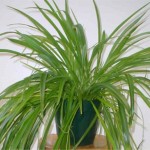By MC Milker
The Not Quite Crunchy Parent
 Just as doing things the old fashioned way, from cloth diapers to wax paper turns out to be good for the environment, so too does cleaning the air using that retro favorite…plants.
Just as doing things the old fashioned way, from cloth diapers to wax paper turns out to be good for the environment, so too does cleaning the air using that retro favorite…plants.
Most of the attention recently has been, as it should be, on the big picture clean air issues: how pollutants impact our breathing air and how industry destroys some of our major sources of oxygen, the rain forests and seaweed beds.
However, as we move closer to home, an old and moldy NASA study, Foliage Plants for Removing Indoor Air Pollutants from Energy Efficient Homes, is recently receiving another look.
The accumulation of gaseous toxic substances in the air of poorly ventilated places has been known for many years but only in recent years recognized as a potential indoor health hazard….Owing to the ubiquitous and increasing use of resins and solvents in most materials found inside modern homes, indoor air pollutants such as formaldehyde have increased significantly over the past years. The adoption of energy saving proposals to reduce ventilation rates in homes has aggravated the problems of indoor air quality and increased potential health hazards
Great – eco friendly but unhealthy.
Fortunately nature provide an answer here too. House plants.
Based on the study results, one plant per 100 to 120 square feet of living space provides the air cleaning power necessarily to negate the effects of harmful toxins in the air. I suspect however that depends a lot of exactly what indoor air pollutants can be found in your home.
The EPA publishes a booklet on indoor air pollution and provides information and resources on indoor air pollution (and incidentally refutes the NASA study – there’s government for you!). But, it’s a good starting place.
The best method of determining your level of indoor air pollutants is to have a professional analysis conducted. Check for indoor air quality testing services in your neighborhood. Then remove offending materials and oh yes, grow lots of indoor plants.
Related posts: Toxins in Commercial Air Fresheners – Report Finds Phthalates in Popular Brands
Great post, MC! Do you happen to know which of those plants are particularly hardy? I like to make sure plants in my household have reasonably strong constitutions. 🙂
My spider plant has taken a lot of neglect and keeps on ticking.
Philodendron (slow grower) and pothos (devils ivy- fast grower) will tolerate just about anything: low light, bright light, high or low water. If they start to look ratty from too much neglect or too much love, cut them back severely, treat them better and they’ll come right back. Peace Lily (or spathophylum) and spider plant are also pretty hardy but need more regular watering and mid-level lighting. Again, cut them back if you need to start over. Ivy will tolerate a lot as well but it is such a dull plant. Dracena, mums and daisies are much more finicky with the later two being more temporary indoor residents than permanent. Happy to field individual plant questions at my blog.
Thanks Jennifer and Heidi! Pothos has been my staple houseplant since I went to college…I’ll look into branching out to some of the others you mentioned. 🙂
Heidi,
Thanks for the additional information! That was great!
I love houseplants and need to get more. I finally managed to kill my wandering jew after several years, a move, and children.
I get annoyed by the “air cleaners” that you spray into the air. Yeah. Clean the air by blasting it with chemicals. That works!
There’s a book called “How to Grow Fresh Air” published by Penguin Books in 1997. It’s based on a NASA study (maybe the same?). The nice thing about the book, at least for this brown thumb, is that they rate the plants on various things, including ease of maintenance.
Enjoy!